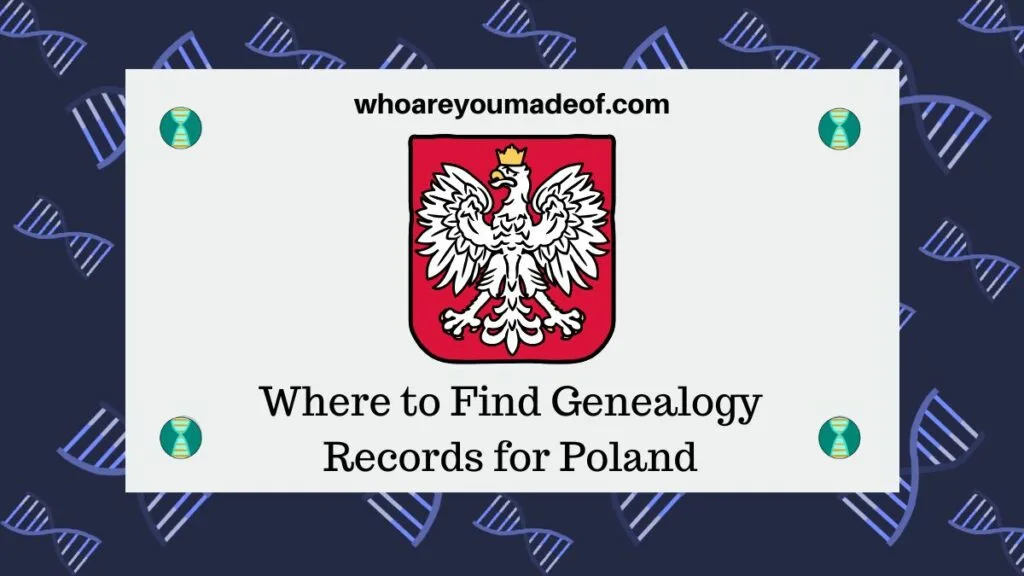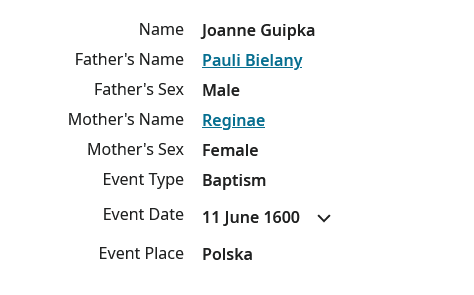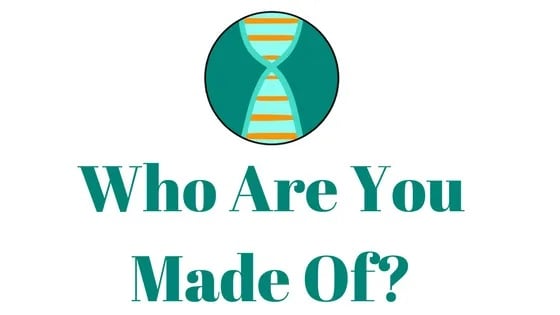If you have ancestors from Poland and you are looking for the best places to find records online, this article is for you. In this post, learn the top places to search for Polish genealogy records and tips for using the databases.

Two of my great-grandparents came to the United States from Poland in the 1890s. My ancestors were from two different parts of Poland because they didn't come to this country together.
Instead, they met in New Jersey and decided to get married. The rest, of course, is history.
I have a few other great-grandparents who were not ethnically Polish, but they came to the USA from what we now consider to be Poland. Finding records about these ancestors turned out to be tricky.
Below, I share with you what I have learned from researching this history. Hopefully, it helps you find out information about your Polish (or non-Polish ancestors from Poland) more easily.
Some of these records require a subscription, while others don't. I recommend trying the free sites and then coming back to the sites that require a subscription once you have a better idea of the exact records that you are searching for.
Ancestry
Ancestry is my favorite website for searching for records due to its ease of use, and because of the sheer volume of records that have been indexed and digitized for the site. There are currently 206 records collections for Poland covering time periods as far back as the 1500s.
Many millions of Polish people and non-Poles living in Poland were recorded in these records.
While a subscription is required to view some Polish records on Ancestry, there are many collections of records that have been made available for free to anyone with a free Ancestry account. It is always worth taking a look to see what information you can find on Ancestry, since you never know what you might discover.
You can view Ancestry's Polish collections here: View Polish records collections on Ancestry.com
Family Search
Family Search has records for many millions of people in Poland going back as far as 1568, and everything that can be accessed on the website can be viewed for free, as long as you have created a free account.
Many of the records allow you to view the original, digitized image. Sometimes, however, you may only be able to access the indexed information.
For example, I found a record for Joanne Guipka, a female born in Poland in the year 1600. I can't view the image without visiting a Family Search family research center, but I can see details about the record.

You can view and search the Polish records collections on Family Search using this link: Search Poland Genealogy records on Family Search
If there are images that you can't view online, you might be surprised to know that there may be a Family Search research center located near you. There are more than 3500 such centers in the United States.
I live in a fairly rural area, and there are eight centers within a 30-90 minute drive from me. What I usually do is make a research plan for visiting the centers before I contact them and make the trip, which ensures that I make the most of my time visiting the center.
Geneteka
Geneteka is a free Polish website that is the largest source of information for Polish genealogy. There are tens of millions of databases represented on this website, and you can view the databases and available images completely for free.
Before you get started trying to use Geneteka, you should know as much as you can about where in Poland your Polish ancestor is from. This is because, just like in the United States, there are many people in Poland with similar names and you do want to make sure that you find the correct record for your ancestor.
You can try searching on Geneteka here: Do a Geneteka search
If you already know where in Poland your ancestor lived, you can try searching for them on Geneteka. There is a button to click to translate the site into English if your browser doesn't automatically do so.
When you find records that match your search criteria, you see if a scan is available ("skan" in Polish) by seeing if there is a "SKAN" button visible to the far right of the record. If there is no SKAN button, this means that there is no digital image available for you to view, though the information in the index may still be helpful to you.

If the database or record is maintained by the Polish government archives, you may no longer be able to view it online through the Geneteka website. Instead, you will have to visit the "Search the Archives" website that is maintained by the Polish government's Narodowego Archiwum Cyfrowego (National Digital Archives).
This leads me to my next suggestion.
Poland's National Digital Archives (Narodowego Archiwum Cyfrowego)
The idea behind Poland's National Digital Archives's website is to be a main repository for all of Poland's records. Dozens of state and non-state institutions contribute towards the archives, making it an excellent source of information.
Searching through the records on this site will require a bit of patience and some time for learning how to use it. There are many millions of records available on this site, however, and they are all for us to view for free.
Check out this help page before you get started searching, and then do your searches here: Search the Polish digital archives. The information that you found on Geneteka may possibly help you know where to look on the digital archives site.
The Poznan Project
Prior to 1918, there was a European country called the Kingdom of Prussia that now forms parts of Germany, Poland, and Russia. One of the provinces of the Kingdom of Prussia was called Poznan (or Posen in German), and this province was split between Poland and Germany around 1920, with about 90% of the territory going to Poland.
The people who lived in Poznan were Polish, but there were also Jewish people and Germans living in this region. In 1815, about 73% of the people in Poznan spoke Polish, and about 25% spoke German, with most of the Jewish population counted in the German-speaking group.
My German ancestors undoubtedly are among the 25% of the population of Poznan that spoke German, yet they lived their entire lives in a place that is now called Poland. So, when I do research about these ancestors, I must consider that some of their records are held in Poland and not in Germany.
Since our Poznan/Posen ancestors are somewhat of a special case, a group of volunteers has undertaken an effort to compile, digitize, and index records for the historic Province of Poznan. These records are available for free at the Poznan Project website.
You can search the database here: The Poznan Project - do a search
CompGen
CompGen is a site run by the largest genealogical society in Germany. As many students of history might know, some parts of what is now Poland were part of Prussia and inhabited by Germans.
If your ancestor lived in Prussia, you might have luck searching one of the connected databases on this site, which contain tens of millions of individual records. All of the records are available for free.
I'm not a German speaker, so I use Google Chrome to use this website. The Google Chrome browser translates the web pages into English automatically, which I find very helpful.
MyHeritage
MyHeritage has extensive Polish records encompassing 14 collections with more than 17 million individual records. It is a paid subscription service, so you will need to have an active MyHeritage subscription in order to access these records.
To do a search, you need to have a free MyHeritage account. To view records, you will need a subscription, but you can still try searching for free to see if any records show up before you decide whether you want to get a subscription.
Conclusion
I hope that this post has helped you learn the places that you should search for records about your Polish ancestors. There are many other places online that might help you, but this list is a good place to start.
If you haven't already, please consider taking a DNA test with one of the top DNA testing sites, such as Ancestry DNA, 23andMe, or MyHeritage. You will receive DNA matches, and this can be a good way to learn more about your Polish ancestors.
If you have any questions about something that you read here, or if you would like to share a favorite resource for Poland genealogy records, please join in the discussion below.
Thanks for stopping by today!

Sheri Margulies-Semel
Sunday 17th of August 2025
For Jewish records, and I have found many of my own ancestors here, I recommend JRI Poland. I did not seen this site mentioned in your list....
Mercedes
Sunday 31st of August 2025
Thank you for this recommendation! I will check it out and add it to the list. Sincerely, Mercedes
Arlene Slobecheski
Monday 6th of January 2025
Thank you so much for all of this information. Through my DNA test and finding out that I have Polish-Russian-Austrian great-grandparents I had no idea where to start. I joined Facebook groups and through one of them found an uncle in Poland whose daughter helped me to discover so much through Genetica. I now know where my great-grandmother was from near Rypin. I am still trying to find out about my great-grandfather as he was from Austria Poland according to his Census Record. They also came here and lived in NEw Jersey in the 1880s but separately, met, and married. Unfortunately, there are no records of them other than one census in 1900. Someone found cemetery plots but no headstones for me in the Catholic cemetery in the town where they lived which is also where most of their siblings lived. It is also where I was born and raised without ever knowing about them. I still cry over having lived just around the corner from some of these aunts, uncles, and cousins and never knowing them. I even went to school with a couple of them. So sad when secrets are kept. But even at 78 years old I am still trying to meet them.
Teresa
Friday 3rd of January 2025
Geneteka is fantastic! Thanks for this great round-up of Polish research sites...I use most of them :)
Mercedes
Sunday 5th of January 2025
I'm so glad you liked the list! Thank you for leaving a comment!